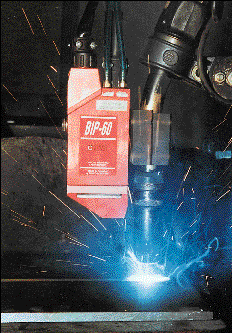Laser Vision Aids Robotic Welders
Michael D. WheelerPARIS -- Shipbuilding plants have sought welders with top-notch skills for years. Now, thanks to photonics, a new breed of welder -- the robotic kind -- could rival humans in expertise and efficiency.
The French Welding Institute developed RoboKid, a robot with a vision system that is based on laser triangulation, a distance measurement technique involving lasers and photodetectors. A rangefinder mounted on the robot's welding torch emits laser light from several perspectives.
Depending on the vision system, Servo-Robot Inc. in Boucherville, Quebec, Canada, installs one of two types of semiconductor laser diodes: one emitting at 780 nm or another emitting in the 810- to 830-nm range. The laser light bounces off the metal part that the robot will weld. The time it takes the laser to reflect to the 3-D camera head determines the location of the part. Software interprets the measurements, which come in at a rate of 40 images per second -- enabling the robot to "see" what it welds and automatically adjust the laser torch so it remains at the center of each weld.

Servo-Robot Inc.'s 3-D laser camera has brought a new level of accuracy and adaptability to robotic are welding. |
Advantages
By incorporating vision in the robot, scientists have eliminated a number of constraints that have hampered its "blind" predecessors. Those robots performed along preset trajectories and required reprogramming any time a different task was required, which often led to lengthy and costly shutdowns while engineers made the necessary adjustments to the software.
Jean-Louis Bréat, a member of the French Welding Institute, said that using a vision system makes it possible for the robot to adjust to real-world conditions. He said it enables accurate calculations of volumes and pass conditions, while the quality and regularity of the molds surpass the results obtained in manual welding.
LATEST NEWS
- Exail Signs LLNL Contract, Partners with Eelume Apr 26, 2024
- Menlo Moves U.S. HQ: Week in Brief: 4/26/2024 Apr 26, 2024
- Optofluidics Platform Keys Label-, Amplification-Free Rapid Diagnostic Tool Apr 25, 2024
- DUV Lasers Made with Nonlinear Crystals Enhance Lithography Performance Apr 25, 2024
- Teledyne e2v, Airy3D Collaborate on 3D Vision Solutions Apr 24, 2024
- One-Step Hologram Generation Speeds 3D Display Creation Apr 24, 2024
- Innovation Award Winners for Laser Technology Honored in Aachen Apr 23, 2024
- Intech 2024: AI Arrives on the Shop Floor Apr 22, 2024
